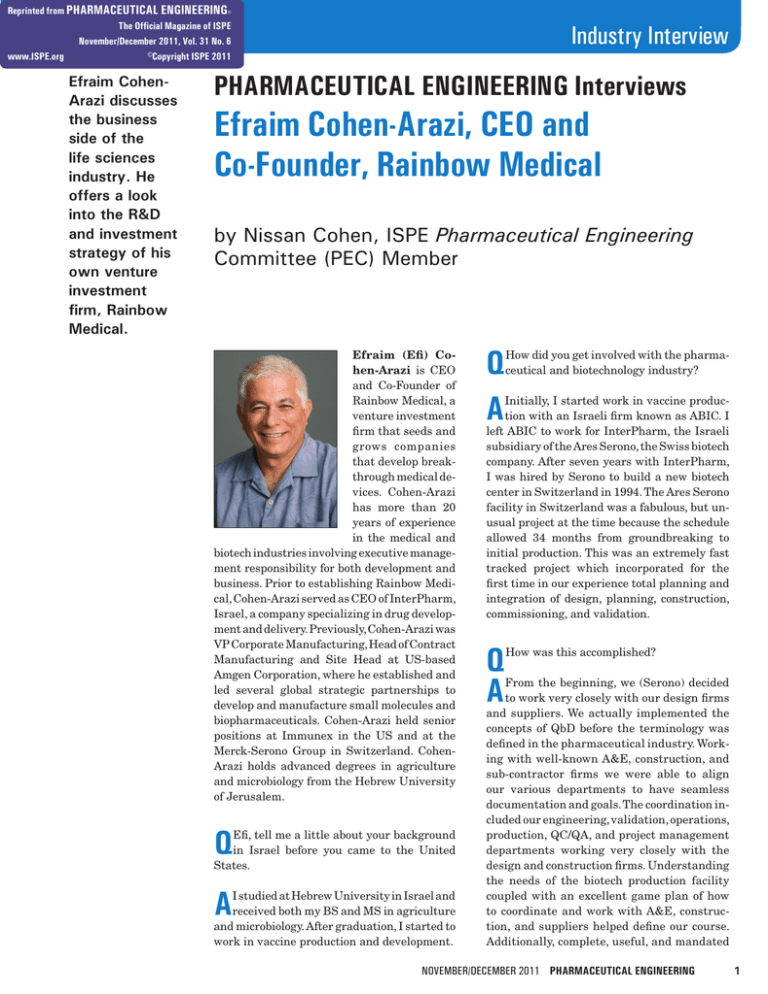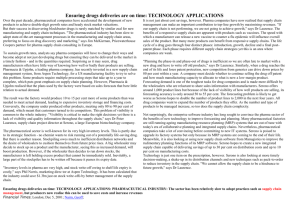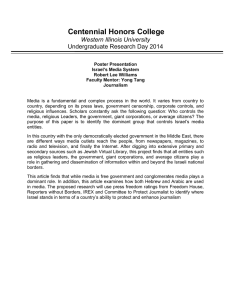Industry Interview
advertisement

Reprinted from PHARMACEUTICAL ENGINEERING® The Official Magazine of ISPE November/December 2011, Vol. 31 No. 6 www.ISPE.org ©Copyright ISPE 2011 Efraim CohenArazi discusses the business side of the life sciences industry. He offers a look into the R&D and investment strategy of his own venture investment firm, Rainbow Medical. Industry Interview Pharmaceutical Engineering Interviews Efraim Cohen-Arazi, CEO and Co-Founder, Rainbow Medical by Nissan Cohen, ISPE Pharmaceutical Engineering Committee (PEC) Member Efraim (Efi) Cohen-Arazi is CEO and Co-Founder of Rainbow Medical, a venture investment firm that seeds and grows companies that develop breakthrough medical devices. Cohen-Arazi has more than 20 years of experience in the medical and biotech industries involving executive management responsibility for both development and business. Prior to establishing Rainbow Medical, Cohen-Arazi served as CEO of InterPharm, Israel, a company specializing in drug development and delivery. Previously, Cohen-Arazi was VP Corporate Manufacturing, Head of Contract Manufacturing and Site Head at US-based Amgen Corporation, where he established and led several global strategic partnerships to develop and manufacture small molecules and biopharmaceuticals. Cohen-Arazi held senior positions at Immunex in the US and at the Merck-Serono Group in Switzerland. CohenArazi holds advanced degrees in agriculture and microbiology from the Hebrew University of Jerusalem. Q Efi, tell me a little about your background in Israel before you came to the United States. A I studied at Hebrew University in Israel and received both my BS and MS in agriculture and microbiology. After graduation, I started to work in vaccine production and development. Q A How did you get involved with the pharmaceutical and biotechnology industry? Initially, I started work in vaccine production with an Israeli firm known as ABIC. I left ABIC to work for InterPharm, the Israeli subsidiary of the Ares Serono, the Swiss biotech company. After seven years with InterPharm, I was hired by Serono to build a new biotech center in Switzerland in 1994. The Ares Serono facility in Switzerland was a fabulous, but unusual project at the time because the schedule allowed 34 months from groundbreaking to initial production. This was an extremely fast tracked project which incorporated for the first time in our experience total planning and integration of design, planning, construction, commissioning, and validation. Q A How was this accomplished? From the beginning, we (Serono) decided to work very closely with our design firms and suppliers. We actually implemented the concepts of QbD before the terminology was defined in the pharmaceutical industry. Working with well-known A&E, construction, and sub-contractor firms we were able to align our various departments to have seamless documentation and goals. The coordination included our engineering, validation, operations, production, QC/QA, and project management departments working very closely with the design and construction firms. Understanding the needs of the biotech production facility coupled with an excellent game plan of how to coordinate and work with A&E, construction, and suppliers helped define our course. Additionally, complete, useful, and mandated November/December 2011 PHARMACEUTICAL ENGINEERING 1 Industry Interview documentation helped bring the Ares Serono facility to operational status in the very short time of 14 months. But most importantly was the team that we put together to lead this project – a wonderful, professional, and dedicated team that worked hard and continuously innovated to make this accomplishment happen. Q How have the transitions in biotechnology applications affected the pharmaceutical industry as a whole and specifically your career? A After working at Serono in Switzerland, I moved to Seattle and became the Senior Vice President of Operations at Immunex. Immunex, at that time, faced a serious production capacity constraint and was in need of radical thinking to develop the proper process modules for biotechnology production in house, while expanding contract manufacturing capacity. Using knowledge gained at Serono, Immunex Operations was revamped in a very short time period with a clear roadmap to eliminate the production capacity constraints. While at Immunex, I was also responsible for the refurbishment and construction of the biotech site in East Greenwich, Rhode Island. This mega-facility was an investment of more than $1 billion and was designed, built, and operational on an accelerated schedule. In our experience, this was the largest single biotechnology production site ever commissioned. Immunex was subsequently purchased by Amgen and I became the Vice-President of Amgen. Q Having lived in both Israel and United States, I understand some of the emotional issues of being away from Israel. Could you comment? A While at Amgen in the mid-2000s, my immediate family was in Israel while I was working at Amgen in the United States. Traveling back and forth between the United States and Israel is not only tiring, but emotionally draining. Amgen knew I needed to extricate myself from the situation. I became an 2 Amgen consultant and continued my relationship with the organization. Q Your current company in Israel is Rainbow Medical, a venture investment firm. How do you evaluate prospective companies seeking investment? A Our firm is funded by and is an active participant in the medical device and medical technology markets. We have investments from many “big pharma” companies and keep a “pulse” on the industry’s needs. Our strategy is a “search and find” investigation. We listen to our investors about the therapies, product development, and developments needed in the industry. Many large corporations do not have the innovation and core competency, internally, to develop new and cutting edge technologies. Rainbow Medical “finds” and invests in cutting edge therapies, technologies, and innovations that may be integrated into a “big pharma” operation at a later date. We have invested in more than 10 firms in Israel which have tremendous potential. Q How has the consolidation of the industry affected product development, clinical trials, and introduction of pharmaceuticals or therapies? A The industry as a whole has been constrained by the FDA. The product development and approval process in the United States is long and tedious. Many companies are concentrating on Europe for product development and clinical trials. Companies are going to Spain, Ireland, and areas of Eastern Europe specifically to conduct clinical trials. This usage of European clinical trials has reduced many of the development-to-clinical cycle times, in some cases, to less than five years. This is a vast improvement over the development-to-clinical cycle in the United States. Q Many medical devices have been developed in Israel, including artificial skin, surgical lasers, and artificial limbs. Do you concentrate on a PHARMACEUTICAL ENGINEERING November/December 2011 particular sector of the medical device industry either locally or globally? A Our emphasis is primarily on developing therapeutic medical devices in Israel. Israel has a long history of medical device development, some of it due to the advances in the defense industry and infrastructure and some due to war injuries and needed therapies for rehabilitation. Many devices are developed due to the intertwined nature of medicine and science which is prevalent in Israel. Q When assessing a company seeking financing, how are the real and potential products strategically evaluated? Do you assess the manufacturability of the proposed product or technical hurdles to production? A Using our background at Rainbow Medical, we work closely with these companies to assess all aspects of the potential product, not just its development. Manufacturability, technology transfer, clinical production, production process modules, and critical technology parameters, etc., are all assessed using the expertise of Rainbow Medical. Q Does Rainbow Medical help the developing company with expertise or suggestions in manufacturing or technology transfer for clinical testing? A Yes, especially for startups. Founders are often saddled with fundraising to keep their operations solvent. This diminishes the research at the start-up company as many founders of start-ups are the technical expertise of the company. Concentration on the founder’s core competencies of research rather than fundraising and private placements will help the startup thrive. Q What is the typical time duration in years, from a company seeking stage one funding until clinical trials? Is it five years, 10 years, or longer? A It really depends on the sector within the life science industry. Industry Interview In medical devices, it sometimes can take two to three years while in the pharma/biotech it sometimes can take five to seven years to get to clinical trials. But as noted above, the regulatory environment can stifle cycle time for development-to-clinical trials. Europe is a better regulatory environment. Q Do you foresee the development of small innovative entities that only work on an R&D basis, eliminating many large budgets of pharma/biotech companies, with either exclusivity or non-exclusivity to large multinational pharmaceutical companies? A Yes, especially in Israel, as research and development are high priorities and innovation is one of the strengths. Other industries have invested in Israeli hi-tech R&D. Significantly, the American semiconductor industry has many R&D facilities in Israel. The quality of R&D firms in Israel is very strong, but commercialization has not been a great forte. The interleaving of Israeli R&D with European and American “big pharma” can be a significant business model and venture. Q What are the frontiers of the life sciences industry over the next 10, 20, and 30 years? A In the longer term, I foresee a few trends: a. big pharma companies entering deeper into the medical devices area b. big medical devices concerns entering into software and telecommunications c. the creation of a world wide web based healthcare system d. biotech and medical devices companies’ collaboration to target drug delivery e. increased use of MicroElectroMechanical Systems (MEMS) and nanotechnology in the medical devices November/December 2011 PHARMACEUTICAL ENGINEERING 3





